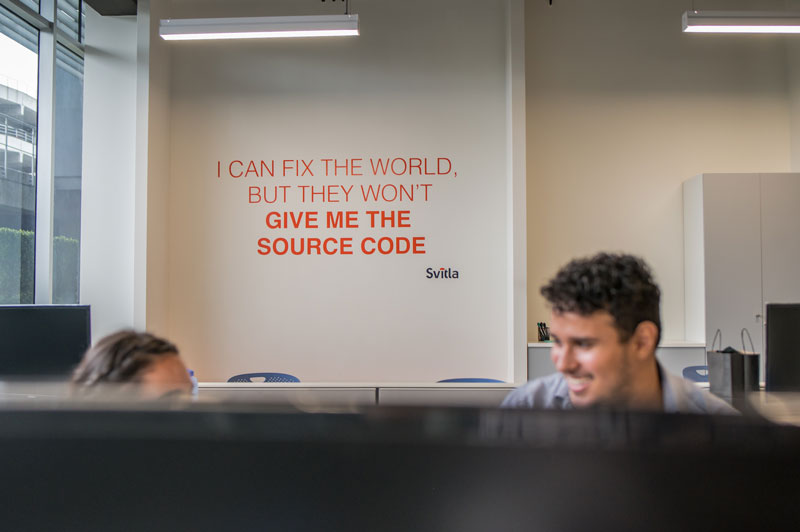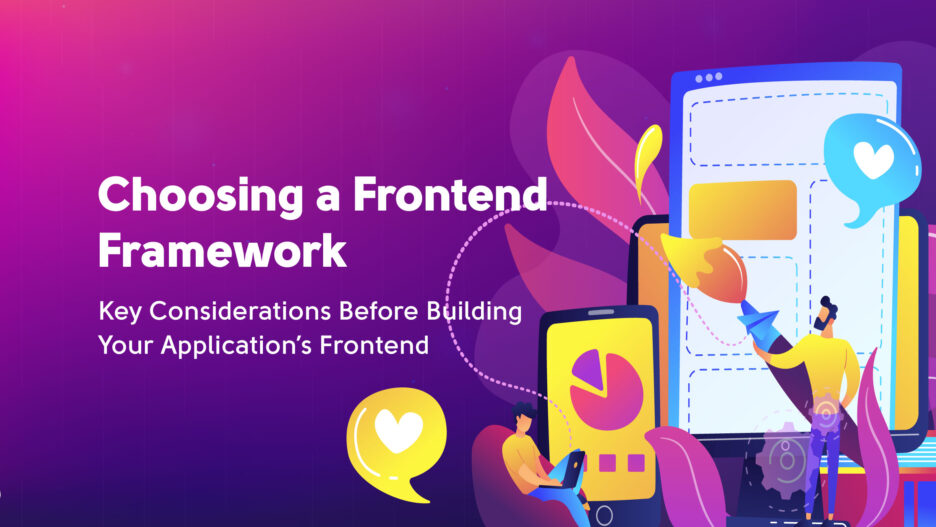Key Considerations Before Building Your Application's Frontend
Every company's first priority when designing a website should be the user's experience. Your users must be able to use and enjoy all the wonderful features and functions you have created. When a user interacts with your website, they should find it easy to navigate, load quickly, and feel like they are in a constant state of flow. A seamless experience.
The frontend of your application is the cornerstone of your user-centric website or application to achieve the modern, user-driven look and feel of today and tomorrow. Choosing the right frontend framework becomes crucial to streamline the development of your interactive, user-friendly apps and websites, and as with everything worth choosing, there are several considerations to take into account before deciding which framework uniquely fits your business needs.
In today's post, we've focused on listing out everything you should consider about a frontend framework before committing to one, realizing the value each one can add to your unique project and business needs.

Why do you need to choose a reliable design frontend framework?
For context, the software backend takes care of all the tasks or operations of your app or website, but it can't interact or communicate with the end user; that's the frontend's job. Any and all user interactions with the application, including the display of UI components like buttons, the landing page, interactive tutorials, or even uploading a file, are handled by frontend frameworks.
Web developers need frontend frameworks to make their jobs easier. These software packages usually include pre-written and reusable code modules, standard front-end technologies, and ready-made interface blocks. This makes it faster and easier for developers to make stable, supportable, high-quality, long-lasting web applications and user interfaces without having to code every function or object from scratch.
As with all things worth having and that make your life simple, there are plenty of suitable options out there, and you'll notice that many of them have JavaScript as the source language. Developers still argue a lot about which one is the best, so if you want to choose a framework that works well for you, you need to think about a lot of factors and details.
For instance, when building software with plain JavaScript code, developers must start from scratch with the code structure for each new project. So, the more complex and advanced an app gets, the more likely it is that mistakes will show up in the code. Developers need tools that help them write solid code and make it easier to work with the Document Object Model (DOM) and application programming interfaces (APIs). This problem was solved by making front-end frameworks.
A web framework is a set of reusable, universal software that gives engineers a base for building and deploying apps. The main job of these frameworks is to structure how code is put together. Today, web frontend frameworks are made up of compilers, helper programs, toolkits, code libraries, and APIs that bring together different parts of a project to make it easier to build.
Each popular web framework has its own way of operating, but they all focus on:
- Making code that can be kept up-to-date and is easy to read, test, and change;
- Reusing parts of complex interfaces; Making interfaces that are consistent and easy to use; and
- Saving time by not having to write a lot of code to solve problems on the front end.
As you'll soon discover, each front-end framework takes care of some of these points, but usually not all of them. For example, Bootstrap focuses on making HTML and CSS that are easy to maintain and uses consistent visual design. Bootstrap has a way to work with each framework, so you don't have to write a lot of plain JavaScript code. Knockout uses a pattern called model-view-view-model (MVVM), but it doesn't have a solid ecosystem. This means that the framework only provides a structure and you'll have to look somewhere else for additional tools. Other frameworks like React, Angular, and Vue are good at organizing how data flows through an application, letting developers focus on changing the data instead of the DOM.
When starting from scratch on a front-end project, business owners should think about the size of the project, the budget, and the skills of the team members, among other things. We'll talk about each factor that can affect how you choose a front-end framework for building web applications. Let's dive deeper into the main things to consider for frontend frameworks in greater detail.
Main things to take into consideration for a design frontend framework
Across key areas like people, frontend tech stacks, speed, budget, project size, and frontend architecture, you can find sub-key areas that are all crucial to consider when choosing the right frontend framework.
From a revenue standpoint, budget and people might take the bigger seats, but from the engineering side, the key considerations will be the tech stack and the project size. They're all important depending on the lens through which they're being looked at, so it's important for organizations to carefully assess frontend framework tools that check as many of the needed boxes as possible. Next, we'll go over some of the most prominent considerations for your strategic frontend decision-making.

JavaScript Frontend Frameworks or TypeScript?
JavaScript and TypeScript are often part of the same conversations. To many, TypeScript is a superior JavaScript version, delivering additional features for large and complex applications. Developed by Microsoft back in 2012, TypeScript is used by Angular for web development services.
JavaScript is still considered the main and first scripting language for web and apps, giving developers the opportunity to use frontend frameworks JavaScript or backend frameworks. But, can JavaScript deal with the load of large applications like TypeScript does?

Even though both languages are different, they share key similarities. JavaScript was originally designed as a client-side language that now also serves the purpose of server-side programming. Over the years, unfortunately, JavaScript has grown too bulky and complex, meaning it will never really take off or meet the expectations of object-oriented programming languages or server-side technology.
TypeScript is object-oriented and can be considered as a superset of JavaScript that can be seamlessly be used for client-side and server-side sites and apps. Worth mentioning, all JavaScript libraries are TypeScript compatible that supports static and dynamic typing, providing namespaces, visibility scopes, classes, unions, inheritance, interfaces, and plenty of other features such as comments, statements, variables, modules, functions, and expressions.
TypeScript works well for both frontend and backend app or site development while JavaScript has made a name for itself for being the go-to language for website design frontend or app development.
Define Expectations from MVP
Finding out whether your app frontend or site will meet and satisfy user expectations while meeting your business needs is probably the first thing organizations need to strategize for. How do you detect, without going over budget, time, and resources, if your software project is fit for end user consumption?
The Minimum Viable Product (MVP) helps organizations perform a preliminary validation of whether something will work or not. How? An MVP is the smallest and quickest working version of a product that a company can make to test how well its business idea works in the real world. Before launching their first product, MVP helps companies answer an important question: are we on the right path?
Some people get the main idea of this technique wrong and think that an MVP is a set of pieces of a product that are released one at a time. Instead, building an MVP is all about avoiding making products that customers don't need by getting feedback from them and researching it further.
Many people think that an MVP is just a version of an app, website, or product that isn't very good. But that's far from the truth. MVPs need to show enough benefits for the future to get and keep early adopters. If the quality isn't good, this idea might not catch on. In fact, putting out a low-quality MVP may make it less likely that an idea or concept will catch on and stay popular.
In the context of frontend frameworks, JavaScript-based frameworks like Angular, React, and VueJS are some of the best js frameworks for making web interfaces that are more dynamic and stable. But if you want to build mobile interfaces, Facebook's React is still a good choice. This makes it easier for you to turn it into a React-Native app without spending a lot of money or time. On the other hand, if you want to make the next best cross-platform app, Google Flutter is also a great choice.
Define requirements for UI/IX
The first step in the UI/UX process is to gather requirements, which is a crucial aspect of frontend development (and any other development). This is the project's foundation. Requirements Gathering is an important first step in the product development process as it brings together the UI/UX team and the customer team to talk about the project's goals and details.
At this first stage of a project, the goal is to get the right content and the right amount of content so that the UI/UX process can be built correctly and the product will be a success. To get the right content, all you have to do is ask the right questions and talk to the right people.
The Requirements Gathering stage is tasked with getting the most accurate information about a proposed product, and as stated earlier, this is crucial in the context of frontend development. There are different types of requirements to consider when thinking about your frontend, such as:
Product requirements
- What's the purpose of the product
- What pain point(s) does it solve
- What is its unique set of features and capabilities
User requirements
- Who is the main user of your product
- What are the user characteristics in terms of age, geography, lifestyle, etc.
- How will the user interact with the interface
- Is the user willing to spend an amount of money for the product
Business requirements
- How will the product be sold/distributed
- Will the product have a supported gateway if users run into an issue
- What are the product's customer channels
Technical requirements
- Which operating system will be used to develop the product
- Which devices will the product support/need
- Does the product have any limitations in terms of technology
Taking Into Account Responsive Design
When the Internet first started, most people used desktop computers. Today, you can use the Internet on desktops, laptops, tablets, smartphones, cars, and even refrigerators! People have a right to expect that websites will look good on all devices, which is made possible because their design is responsive.
Websites were not always made with responsive design in mind. Before responsive design came along, web designers and developers used a lot of different methods. In the early days, making pages with a width of 640 pixels was a safe bet. But while phones and cameras got smaller, screens got bigger. Before long, most screens were 800 pixels wide and 600 pixels tall. Web designs changed to reflect this. Designers and developers began to think that 800 pixels were a safe starting point.
Then, screens got even bigger. The standard size became 1024 by 768, with most designers using layouts with a set width, but some chose to make their layouts flexible. Instead of using fixed widths for layouts, designers could use percentages for column widths to make a layout that can be changed. These designs work better than layouts with a fixed width, which only look good at one size. These were called liquid layouts which could look good on a wide range of widths but will start to look bad at the very narrow and very wide ends.
Next, when media queries were first added to CSS, they made it possible for layouts to be more adaptable. But many developers still felt most at ease making layouts with a fixed width. One way to do this was to switch between a few fixed-width layouts with set widths. This is what some people call "adaptive design." Adaptive design let designers make layouts that looked good at a few different sizes, but the design never looked quite right when viewed between those sizes.
Responsive web design is a mix of media queries and liquid layouts. You can now make websites that are responsive in many more ways than just the size of the page view. Media features let developers know what users like and let them make experiences that fit their needs.

Planning Search Engine Optimization
Search engine optimization (SEO) is the process of improving your site's search results to get more people to notice it. Every day, millions of people use the Internet to look for brands, answers to their questions, and other useful information. It's up to the organization to ensure the site comes up first when a user searches for something. If what's offered is what the user is looking for, then optimizing the search engine to get to the top of the search results is very important.
There are different ways to achieve SEO. For instance, you could start with keywords. Keywords are short phrases that tell people what your page is about and help them find it (via search engines). To make your keywords, you need to say what you want people to search for. To do this, you'll need to use an analytics tool like Google Analytics or HubSpot to find out what people are searching for when they find you online. The best way to come up with keywords is to walk a fine line between how competitive they are and how well they convert.
Getting users to click on your site is crucial. For instance, the title tag is your 50-character hook to get a web user to click on a page. It should tell the user quickly what they can expect from this page without going into too much detail. Basically, it's the seller tag for a page. Another item worth optimizing is the meta description. The meta description summarizes a content's page in a few, to-the-point sentences.
Capability of Your Development Team
Collaborating with the right development team is essential to the success of your frontend development framework. For instance, Svitla Systems offers the Team Extension engagement model, a way of working together that's especially good for companies that need specialists on deck to handle specific types of work or when the company needs to expand their headcount to address rising workloads.
In Svitla's Team Extension engagement model, Svitla developers are an important part of the client's team for the whole duration of the project. They learn about the project and culture and become a part of it, becoming instrumental to help companies achieve their strategic goals.
Regardless of whether teams are in different time zones or not, or have special compliance needs, a team extension engagement model can be a great way to get the right kind of specialists who will work on your frontend development project 100% of the time.
Choosing a Frontend Framework Based on the Requirements of your project
While there's no one rule for picking a front-end framework for a project, keeping in mind the answers to the previous considerations will give you a great starting point. As you know, different tools and ways of doing things are needed for different projects which is why before choosing a frontend framework, it's a good idea to look at what the project's goals are. For starters, it's crucial for business owners to think about whether the project will be built from scratch or if the front end of an already existing site or app needs to be updated.
Depending on the technology stack being used, there are different ways to update an existing front end. For example, one of the best things about the React and Vue frameworks is that they are easy to add to front-end solutions that are already in place. By adding new parts, software developers can gradually change and update the front end.
But sometimes it's not possible to add to the existing solution or update the version of the framework. Let's consider the scenario of an old front end. If an old frontend was built with a technology that is now out of date, it may be easier and cheaper to build frontend with a completely different framework than to try to update the old frontend, which would require finding software developers who know how to use the old technology. Next, let's review in more depth what project-based considerations to account for when choosing the right frontend framework for your plans.
QA and Test Automation according to your frontend framework
As more businesses try to offer tech-based products and services, loading speed, bandwidth usage, and other performance factors are becoming more important to make sure customers get the experience they want. This makes frontend quality assurance (QA) and test automation crucial. For instance, let's say you have a "golden" framework that you're partial to for your frontend development, but does it cover QA and test automation?
Front-end testing is a way to test web applications or software's Graphical User Interface (GUI), as well as how well it works and how easy it is to use. The goal of frontend testing is to test all of a program's functions to make sure that as updates are made, the presentation layer of a website or piece of software is free of bugs.
In short, frontend testing tests how easy it is to use and how well your front-end application works. Usually, this means validating menus, forms, buttons, and other parts of the application that end users can see. For instance, frontend tests protect your app from regression. In some cases, you might write code that helps you deploy big or complicated features, but it could crash another part of the app that you didn't know about. Regression testing is advised to catch such issues and resolve them so that your users never see them.
Additionally, frontend QA helps establish greater trust in your code and the overall app or website's reputation or ranking. Trustworthy code makes for easier and less stressful software deployments, but it also gives users a reliable experience that will prevent them from deleting your app or closing the site. In fact, highly usable and stable software tends to attract repeat users, some of whom will recommend your software to other users.
Another selling point of QA and test automation in your frontend development is the fact that tests that are kept in good shape are also useful because they can be used as live documentation. When you write tests, you need to be able to explain what each test does and how it fits into your application.
The best tools for testing the front end will include:
- Easy creation and maintenance of test scripts
- High-end reporting capabilities
- Seamless integration with other components
- Insights into performance metrics
- And, most importantly, automation tools
Automation is necessary for effective and fast frontend testing because manual testers can't be expected to keep running tests after every update. This is another area where Svitla excels.
Best FrontEnd Framework 2023?
From this exhaustive list of key considerations to take into account when choosing the right frontend framework, you may have deduced that it's complex to choose a single greatest framework as each aspect offers something unique to evaluate. The reality is that each frontend framework will come with strengths and weaknesses, as well as plenty of discrepancies and nuances.
If you're not sure which front-end development technology will work best for your project, you can get in touch with Svitla Systems for expert advice. Our professional engineers and consultants have extensive expertise in Web Development and will easily help you choose the right technology. Our skilled front-end developers have ample experience building frontends from scratch, supporting existing frontends including legacy code of old frontends, and as such, they will be happy to help you build a high-quality product using the technologies that work best for your situation.
Contact us, and we'll get back to you promptly.




![[Blog cover] How to build a secure DevOps cycle](https://svitla.com/wp-content/uploads/2025/07/Blog-cover-How-to-build-a-secure-DevOps-cycle-560x310.jpg)
